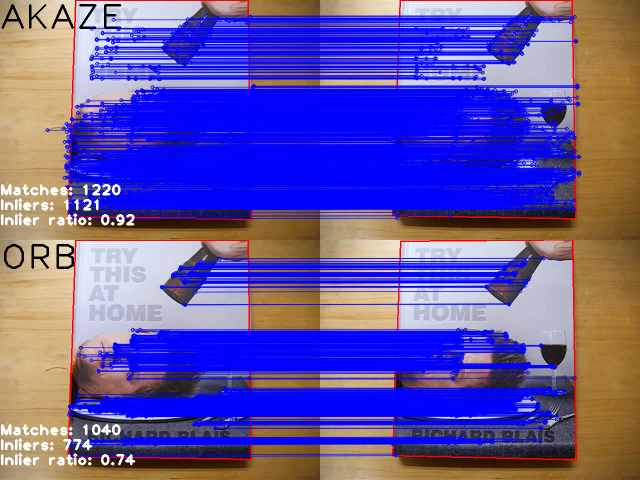1
2
3
4
5
6
7
8
9
10
11
12
13
14
15
16
17
18
19
20
21
22
23
24
25
26
27
28
29
30
31
32
33
34
35
36
37
38
39
40
41
42
43
44
45
46
47
48
49
50
51
52
53
54
55
56
57
58
59
60
61
62
63
64
65
66
67
68
69
70
71
72
73
74
75
76
77
78
79
80
81
82
83
84
85
86
87
88
89
90
91
92
93
94
95
96
97
98
99
100
101
102
103
104
105
106
107
108
109
110
111
112
113
114
115
116
117
118
119
120
121
122
123
124
125
126
127
128
129
130
131
132
133
134
135
136
137
138
139
140
141
142
143
144
145
146
147
148
149
150
|
AKAZE and ORB planar tracking {#tutorial_akaze_tracking}
=============================
@tableofcontents
@prev_tutorial{tutorial_akaze_matching}
@next_tutorial{tutorial_homography}
| | |
| -: | :- |
| Original author | Fedor Morozov |
| Compatibility | OpenCV >= 3.0 |
Introduction
------------
In this tutorial we will compare *AKAZE* and *ORB* local features using them to find matches between
video frames and track object movements.
The algorithm is as follows:
- Detect and describe keypoints on the first frame, manually set object boundaries
- For every next frame:
-# Detect and describe keypoints
-# Match them using bruteforce matcher
-# Estimate homography transformation using RANSAC
-# Filter inliers from all the matches
-# Apply homography transformation to the bounding box to find the object
-# Draw bounding box and inliers, compute inlier ratio as evaluation metric

Data
----
To do the tracking we need a video and object position on the first frame.
You can download our example video and data from
[here](https://docs.google.com/file/d/0B72G7D4snftJandBb0taLVJHMFk).
To run the code you have to specify input (camera id or video_file). Then, select a bounding box with the mouse, and press any key to start tracking
@code{.none}
./planar_tracking blais.mp4
@endcode
Source Code
-----------
@include cpp/tutorial_code/features2D/AKAZE_tracking/planar_tracking.cpp
Explanation
-----------
### Tracker class
This class implements algorithm described abobve using given feature detector and descriptor
matcher.
- **Setting up the first frame**
@code{.cpp}
void Tracker::setFirstFrame(const Mat frame, vector<Point2f> bb, string title, Stats& stats)
{
first_frame = frame.clone();
(*detector)(first_frame, noArray(), first_kp, first_desc);
stats.keypoints = (int)first_kp.size();
drawBoundingBox(first_frame, bb);
putText(first_frame, title, Point(0, 60), FONT_HERSHEY_PLAIN, 5, Scalar::all(0), 4);
object_bb = bb;
}
@endcode
We compute and store keypoints and descriptors from the first frame and prepare it for the
output.
We need to save number of detected keypoints to make sure both detectors locate roughly the same
number of those.
- **Processing frames**
-# Locate keypoints and compute descriptors
@code{.cpp}
(*detector)(frame, noArray(), kp, desc);
@endcode
To find matches between frames we have to locate the keypoints first.
In this tutorial detectors are set up to find about 1000 keypoints on each frame.
-# Use 2-nn matcher to find correspondences
@code{.cpp}
matcher->knnMatch(first_desc, desc, matches, 2);
for(unsigned i = 0; i < matches.size(); i++) {
if(matches[i][0].distance < nn_match_ratio * matches[i][1].distance) {
matched1.push_back(first_kp[matches[i][0].queryIdx]);
matched2.push_back( kp[matches[i][0].trainIdx]);
}
}
@endcode
If the closest match is *nn_match_ratio* closer than the second closest one, then it's a
match.
-# Use *RANSAC* to estimate homography transformation
@code{.cpp}
homography = findHomography(Points(matched1), Points(matched2),
RANSAC, ransac_thresh, inlier_mask);
@endcode
If there are at least 4 matches we can use random sample consensus to estimate image
transformation.
-# Save the inliers
@code{.cpp}
for(unsigned i = 0; i < matched1.size(); i++) {
if(inlier_mask.at<uchar>(i)) {
int new_i = static_cast<int>(inliers1.size());
inliers1.push_back(matched1[i]);
inliers2.push_back(matched2[i]);
inlier_matches.push_back(DMatch(new_i, new_i, 0));
}
}
@endcode
Since *findHomography* computes the inliers we only have to save the chosen points and
matches.
-# Project object bounding box
@code{.cpp}
perspectiveTransform(object_bb, new_bb, homography);
@endcode
If there is a reasonable number of inliers we can use estimated transformation to locate the
object.
Results
-------
You can watch the resulting [video on youtube](http://www.youtube.com/watch?v=LWY-w8AGGhE).
*AKAZE* statistics:
@code{.none}
Matches 626
Inliers 410
Inlier ratio 0.58
Keypoints 1117
@endcode
*ORB* statistics:
@code{.none}
Matches 504
Inliers 319
Inlier ratio 0.56
Keypoints 1112
@endcode
|